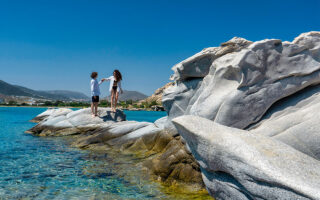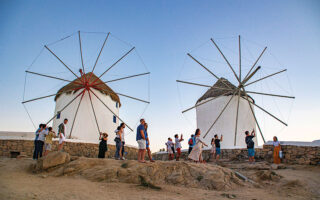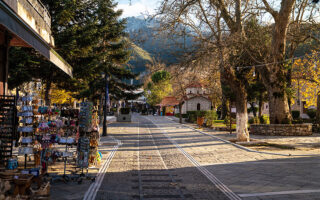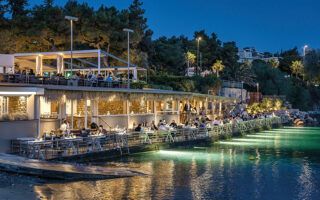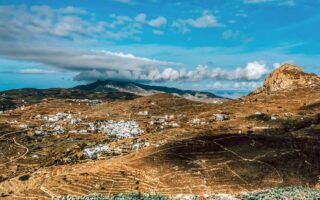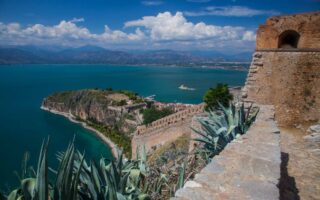Kefalonia – Nature in the Spotlight
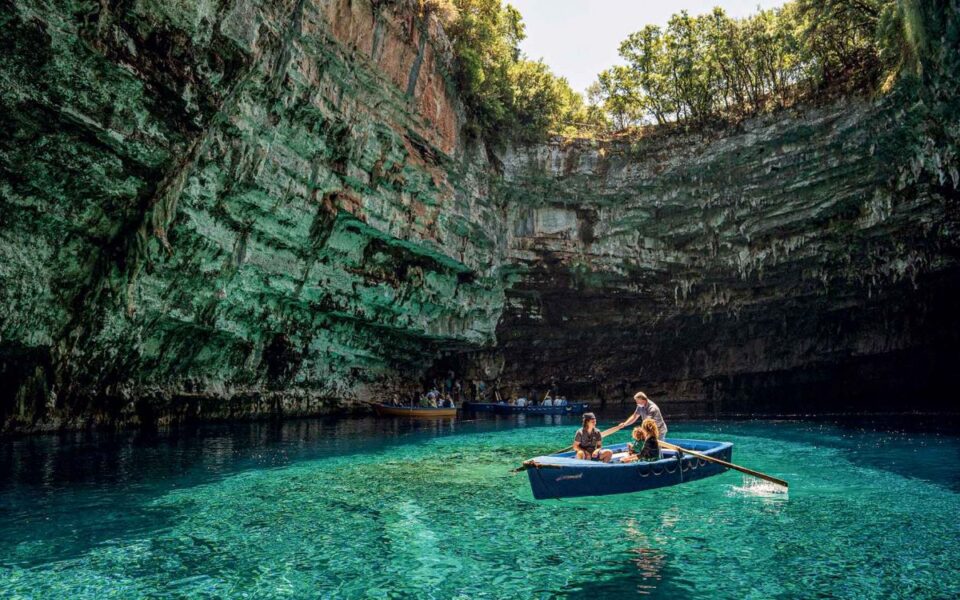
A silent electric boat, whose batteries have been charged with photovoltaic panels, is floating in the Koutavos lagoon in Argostoli, where on occasion dozens, if not hundreds, of sea turtles gather. Each one with its distinctive sign – some with a mark on the face, another with a shorter rear fin, all of them completely unknown to the average visitor… but not to Josh. This blond, long haired Swiss-German runs up and down with his flip flops, checking how many and which turtles are in Koutavos at any moment.
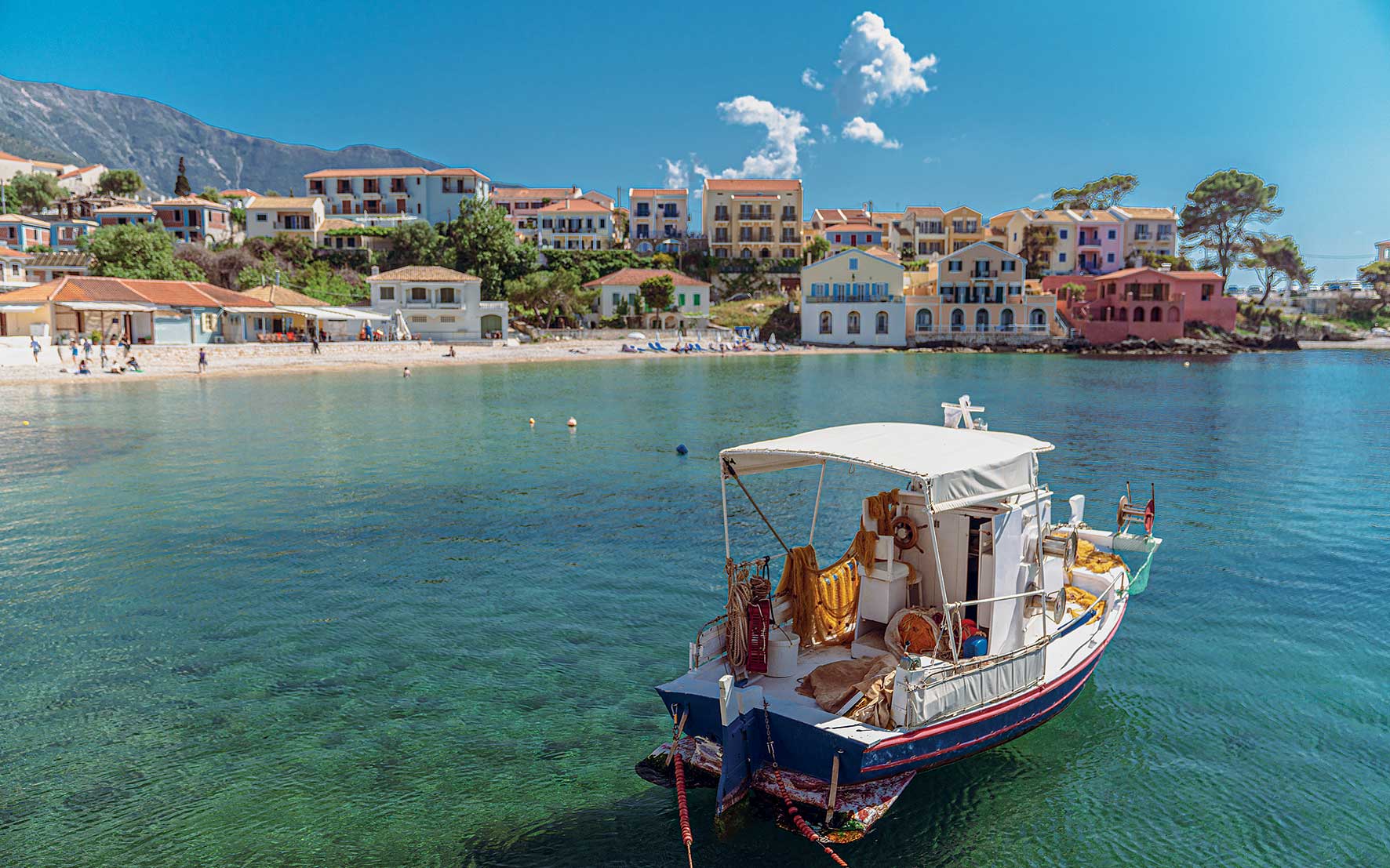
It is moving to see a foreigner working at Wildlife Sense, the environmental organization active in Kefalonia since 2012, and to be involved with “our” sea turtles with such passion. The dozens of volunteers they see every summer are also foreign; young romantic kids, usually from Western Europe, come to volunteer on the Caretta caretta nesting beaches. And while we know that in Greece our relationship with nature is troubled, it would be unfair to say that it is not improving. Or in this particular case, that the Kefalonia locals are not interested in the turtles at Koutavos, since every one of the passersby, as soon as they identified the Wildlife Sense team wearing their blue t-shirts, immediately informed them of a “troubling” incident that took place between two turtles the previous night, when one of them “did something” to the other. In response, they were reassured that the animals were just trying to mate.
Caretta caretta sea turtles are among the most important creatures on Kefalonia, with perhaps an unfair advantage. They always excite our imagination, and attract the attention of locals and visitors alike. But there are more. Bats and pigeons may not be surrounded with so much fame and glory, but they lead us to the most interesting parts of the island: its caves.
Due to its proximity with the Hellenic arc (the most tectonically active region in Europe), Kefalonia has a special geology that includes chasms, sinkholes, dolines and many caves. One example is the Zervati cavern, the collapsed roof of which has created a debris cone in its center, dividing two lakes with brackish water. Drogaratis, with its phantasmagorical, ornate stalactites that make the cave look like a royal theater, is another.
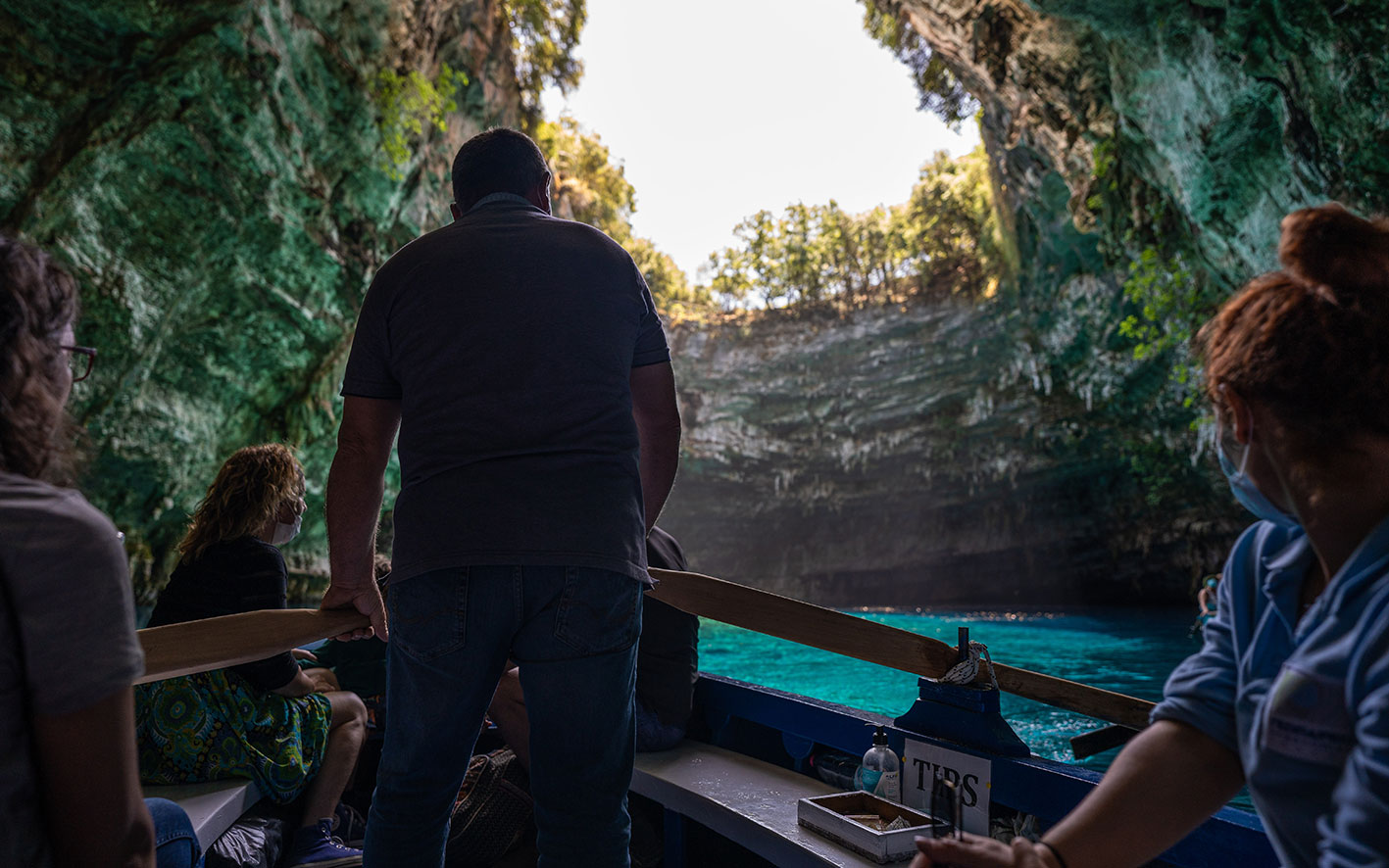
However, the most well-known cave of Kefalonia is the one at Melissani. This cave/doline is located in a lake, 20 meters below the ground. Light enters from a natural source – a round opening surrounded by trees, creating a green halo that gives its waters amazing shades and hues.
The beauty of Melissani is an incredible sight. Much like the people who visit the cave, an extremely large number during high season. The absolute rulers of Melissani today are the boatmen, each with their own temperament – one is rather serious, the other less so, one is jolly like ours, who after describing the basic characteristics in English for the foreign tourists begins singing rhymes about Kefalonia. It seemed as if the cave were an opera hall, he were a baritone and we were the audience. As the expressive and outgoing gondoliers are associated with the city of Venice, these boatmen are inextricably linked with the cave of Melissani.
Today the boatmen may determine its fate, but it was not always this way. Several thousand years ago, the master of Melissani was the most destigmatized of the gods, the least handsome but also the most erotic, with his goat-like form reminding humans of their animalistic side. Pan was worshiped in Melissani, as well as in many other caves across Greece. The god of shepherds and hunters did not need any temples; his sanctuary was the cavity of every rock. Archaeologist Spiros Marinatos (known for his excavations of Akrotiri in Santorini), who hailed from Kefalonia, was involved with the excavation at Melissani where, among others, a figurine of Pan and a plate with dancing nymphs were found.
Horses and violas
Lagoons, lakes, mythical caves. In Kefalonia nature is the element that dominates the landscape and has defined, more than anything else, its identity. The largest of the Ionian Islands, the sixth largest island in Greece (after Crete, Evia, Lesvos, Rhodes and Chios) has not been changed by human intervention. Its beauty has not been “chipped.” As you wander around Kefalonia, it feels as if you are in an enormous forest that also features several small towns, villages and settlements. Here, man comes second after the oak and fir trees.
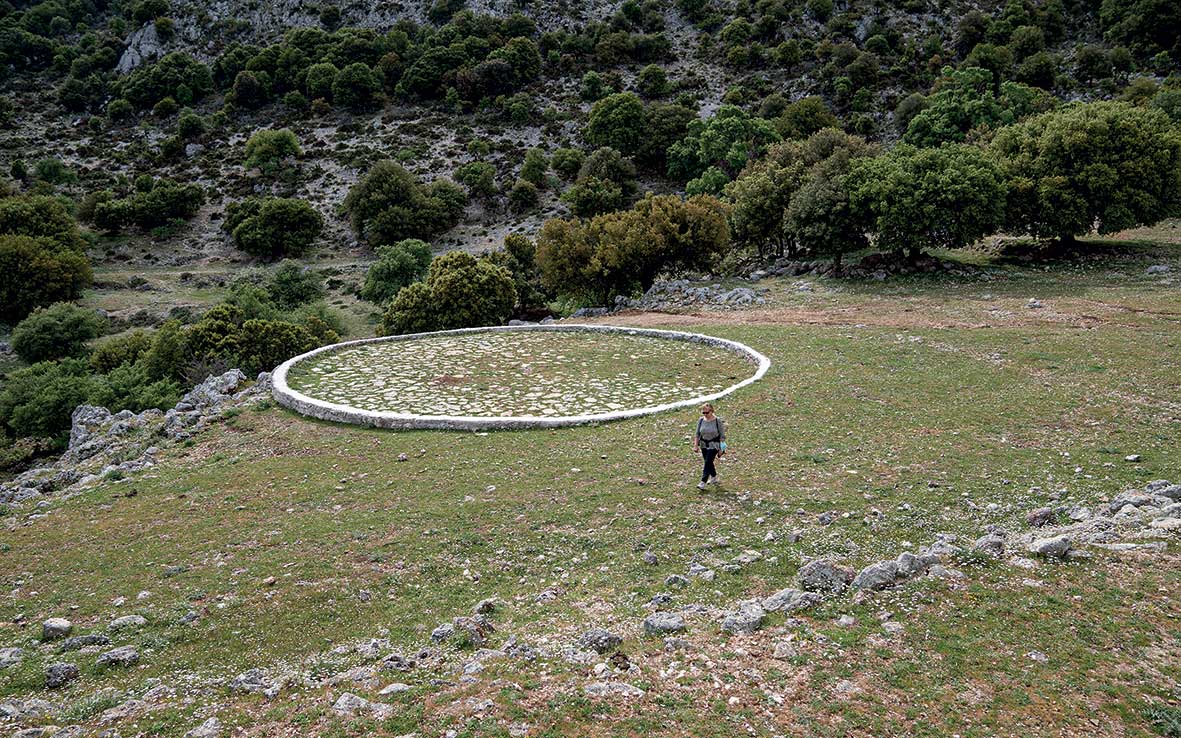
Mount Ainos is one of the most important and recognized natural landscapes in Kefalonia; together with nearby Mount Roudi, they have been declared a National Park since 1962. Both mountains are rather tall for what we expect on islands – Ainos reaches 1628 meters above sea level, the tallest mountain in the Ionian Sea, while Roudi reaches 1125 meters.
The forest filled with the enormous fir trees (Abies cephalonica) was the main reason this region was declared a National Park. However there are also plant species that are not just endemic to Greece or Kefalonia, but just to the park itself – for instance Viola cephalonica, a small flower with mauve petals that grows on rocky terrain or between the rocks, is mostly located at Hionistra around the antennae.
But there is a certain particularity in this national park that I could not imagine possible in a 28,620 square meter expanse: there are not many animals. Or rather, there are no animals we usually find in fairytales, the ones we identify as “forest animals.” So while there are yellow-necked mice, glis glis doormice, martens, rabbits, and insect-eating moles who live below the ground in tunnels, there are no larger mammals such as deer, roe or wild boars.
What one may come across on Ainos, if they are lucky, is a herd of semi-wild horses that wanders around the southeastern flanks of the mountain. Their fame has been going strong for decades. If you speak to tourists who visited the mountainous regions of the island some ten, twenty, even thirty years ago, it is the “horses of Ainos” that made the greatest impression. We were not able to catch a glimpse, they did not grace us with their presence. It does not matter though, because when we say semi-wild horses, this is exactly what we mean – they come and go, and meeting them is not a given. Should it happen, it is considered a gift. If not, their absence confirms their freedom.
From coast to coast
Finally we have the beaches, the greatest travel advantage of Kefalonia, an insuperable strong point that retirees from Western Europe already begin enjoying from early May – while they enjoy the benefits of the soft spring sun, bees are pollinating the flowers nearby. This is a great time to come as they support the tourism of the island off season – yet one wonders why Greek retirees are not taking advantage of this opportunity. A quick Google search regarding the cost of air travel from Athens to Kefalonia and from Rome or London to Kefalonia may go some way in explaining this, since cheaper airfares allow Romans or Londoners to meet and enjoy Kefalonia more easily and economically than an Athenian ever could.
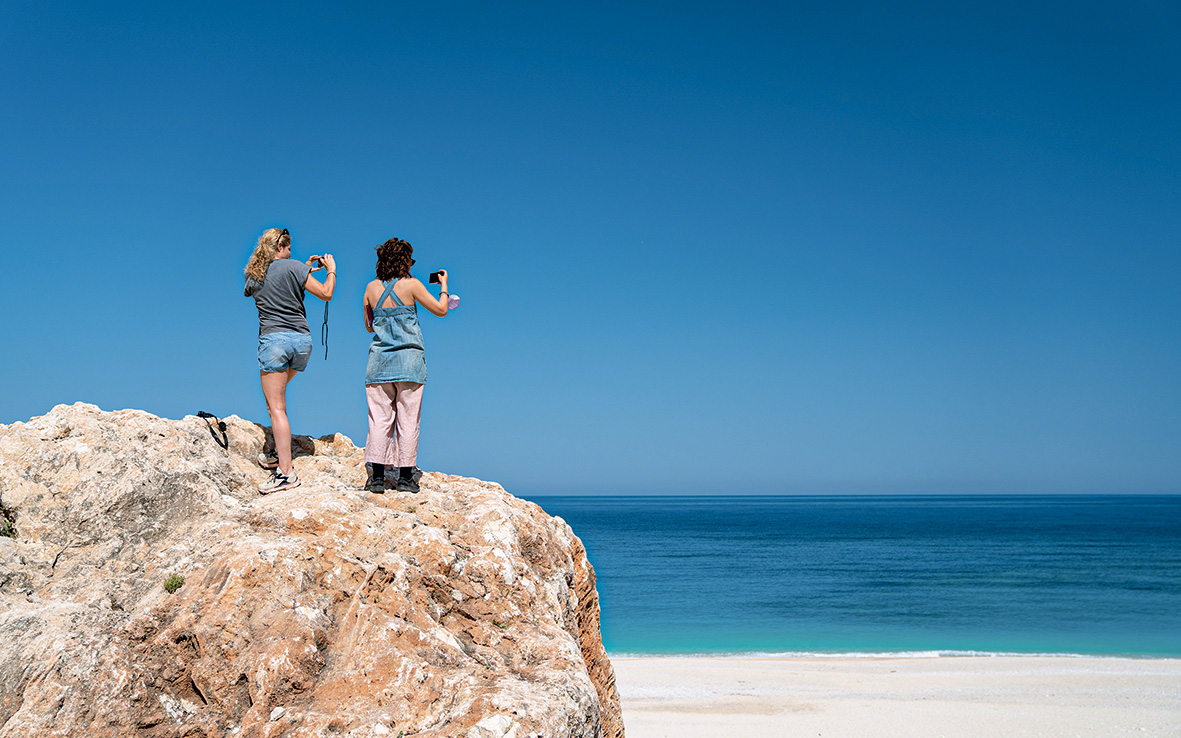
Back to the beaches. The best known beach on the island is Myrtos, large in length as well as in width, covered in sand and stones. On the left side you will find a small cave with its own little beach that is ideal for children.
Fteri is also exceptional, voted by the Guardian newspaper as one of the 40 best beaches in Europe. You cannot get here by car, but via a downhill trail through the forest, a 30 minute hike in all. It is not particularly difficult, there are just some tough sections. On the way you will see an old stone domed structure built to serve the needs of the shepherds, with its simple and archetypal architecture taking you back to stone and mud building techniques.
Antisamos and Koutsoupia are two other great beaches. They are connected via a hiking route that lasts about four hours, traversing a forest and boasting views over: The island of the stoic queen who went down in history for her patience instead of her weaving skills; the home of nostalgia, departure and reunification; the land that is more of an ideal rather than a tangible place, nestled in the heart of every philhellene who ever studied and loved Homer – the island of Ithaca.
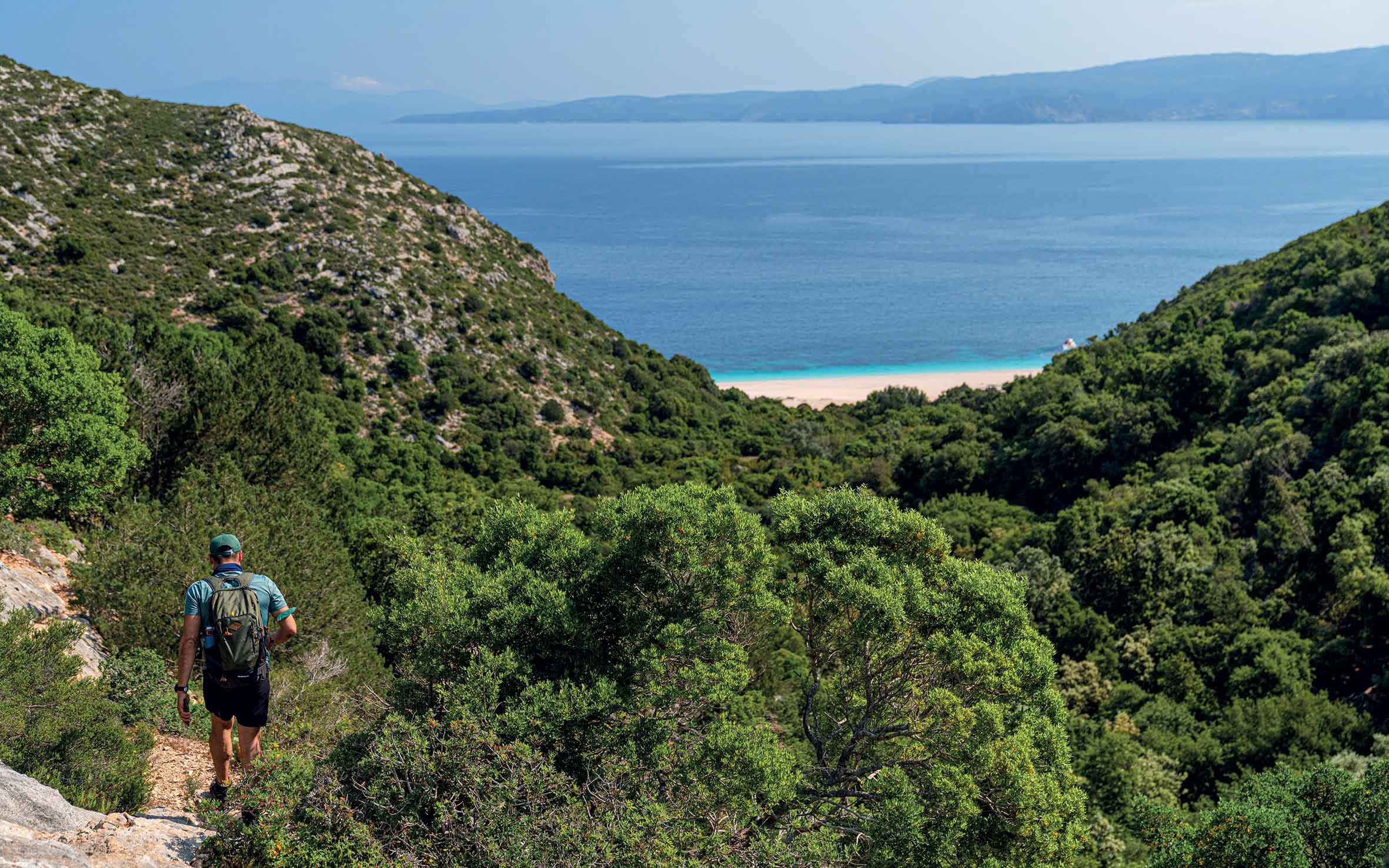
Good to know the natural landscape of Kefalonia
At Koutavos lagoon you can rent a hydrobike or take a ride on an electric boat with Argostoli Lagoon Activities (kefalonia-activities.com).
Melissani lagoon is open every day 09:30-17:00, 8 euros, Tel. (+30) 26740.229.97. The Drogaratis cave is open every day, 9:30-16:30, 5 euros, Tel. (+30) 26740.233.02.
At beaches such as Myrtos be aware of potential landslides.
Mount Ainos boasts a hiking trail network (visit aenosnationalpark.gr for more information). An alternative method of transportation on the mountain is via jeep. The outdoor activities company Wild Nature Expeditions (wildnature-expeditions.gr) organizes road trips.
There is a serious effort to protect the natural monuments in Kefalonia and Ithaca, and the connection with the people and culture of each island. The Kefalonia-Ithaca Geopark was recently included in the UNESCO Global Geoparks network, a recognition and motivation to continue implementing projects to protect and promote the natural landscape. For more information on what the Geopark consists of visit kefaloniageopark.gr.
For information regarding hiking and trekking in Kefalonia visit samitrekking.com.
The Monastery of Themata is a haven with tall, shady trees. Take your checkered table cloth and basket of supplies with you to set up a wonderful summer picnic under the dense foliage.
This article first appeared in Greece Is (www.greece-is.com), a Kathimerini publishing initiative.
